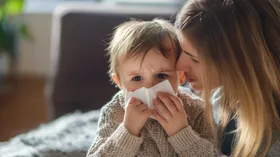Can Kids Get Plantar Fasciitis?
Is your child experiencing heel pain? Learn about plantar fasciitis in children, common causes, and effective treatment methods.
Updated August 14, 2023
Plantar fasciitis is a common condition that irritates the plantar fascia, a thick band of tissue that runs across the bottom of your foot, connecting your heel bone to your toes. It is one of the most common causes of heel pain. Overuse or repetitive strain on the plantar fascia—caused by running, dancing, or standing for long periods—may lead to plantar fasciitis.
While plantar fasciitis is more commonly seen in adults, it can also occur in children, particularly those involved in activities that put repetitive stress on their feet.
Treating Plantar Fasciitis in Children
The treatment for plantar fasciitis in children typically involves conservative measures to relieve symptoms and promote healing. Here are some common treatment options:
- Icing: Rolling the sole of the foot back and forth on a frozen bottle helps reduce pain and inflammation.
- Physical therapy: Physical therapy strengthens the foot muscles, improves flexibility, and promotes proper alignment. Exercises like calf muscle stretches, held for about 30 seconds, and done 2-3 times a day, may help alleviate pain. This is because tight calf muscles add stress to the plantar fascia.
- Massage: Soft tissue massages break up tight fibrous bands, reducing tension and pain. It also increases circulation to the affected area. This can aid in healing and reducing inflammation in the plantar fascia of your child.
- Supportive shoes: Well-fitting shoes with good arch support and cushioning help with plantar fasciitis symptoms. Healthcare professionals may recommend orthotic inserts or shoe modifications for additional support.
Tip: Physical therapy exercises or massages should be done under the guidance of a physical therapist or according to appropriate specialised instructions.
Tailoring Treatment to Your Child's Needs
Treatment plans for plantar fasciitis in children should be customised based on factors such as the severity and duration of symptoms, the child's age, and any underlying issues contributing to the condition.
Luckily, First Walkers' shoes have built-in arch support. This helps maintain the foot's natural arch and reduces the strain on the plantar fascia. Arch support distributes the weight evenly across the foot, reducing stress on the affected area and promoting proper foot alignment. These shoes also help to reduce the impact and pressure on the heel, providing relief and minimizing discomfort during walking, running, or other weight-bearing activities. They have reinforced heel counters and firm midsoles that help stabilize the foot and prevent excessive pronation or supination.
Related Articles

10 Best Orthopaedic Shoes for Kids With Flat Feet
Benjamin Aduwo
December 5, 2024

10 Best Sandals for Toddlers to Stay Cool During Summer 2026
Benjamin Aduwo
December 5, 2024

Dealing With Shoe Allergies in Children: What to Look For
Bhashwati Deb Barma
December 5, 2024

5 Best Winter Shoes for Babies: Keep Your Little One Warm and Stylish
Jasrah Javed
October 8, 2024

How to Tell If Your Baby's Shoes Are Too Small: 5 Signs
Anjana Iyer
April 24, 2025
Related Posts
Babafemi Adebajo
Are Knock Knees Genetically Inherited?
Benjamin Aduwo
10 Best Sandals for Boys to Feel and Look Cool
Jonathan Coom
